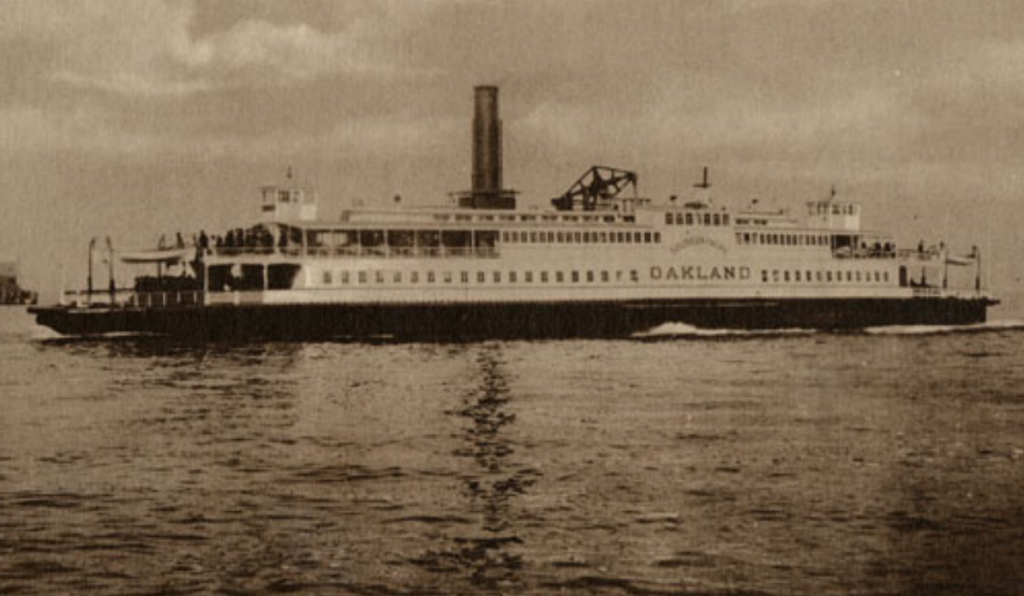Then & Now: Bay Area Ferries
Before its iconic bridges were built, ferries were the transportation mode of choice to crisscross the San Francisco Bay. With ever-increasing traffic headaches, will Bay Area commuter ferry service make a comeback? Some say it already is.
BY RACHEL COHEN | APRIL 2018
Ferry Tale – A History of Ferries in the Bay Area
 Steamboat ferry service began in the Bay Area as early as 1826 between San Francisco and Oakland. Throughout the 19th century, railroad companies led the charge in ferry operation, connecting passengers with the Transcontinental Railroad. As Transbay ferry service gained popularity, hubs appeared in Berkeley, Vallejo and Sausalito. For a time ferries traveled to Alviso, despite difficult navigation conditions. But after a fatal 1853 disaster claimed the lives of 31 passengers, hopes of a South Bay ferry port were dashed.
Steamboat ferry service began in the Bay Area as early as 1826 between San Francisco and Oakland. Throughout the 19th century, railroad companies led the charge in ferry operation, connecting passengers with the Transcontinental Railroad. As Transbay ferry service gained popularity, hubs appeared in Berkeley, Vallejo and Sausalito. For a time ferries traveled to Alviso, despite difficult navigation conditions. But after a fatal 1853 disaster claimed the lives of 31 passengers, hopes of a South Bay ferry port were dashed.
The rise of the automobile left Bay Area drivers seeking connections to newly constructed highways. In 1909, the first auto ferry debuted, featuring a lower deck designated for cars and an upper deck for passengers.
1930s commuters seeking a thrill gained an exciting alternative – the Seaplane. For $1.50, passengers could catch the Air Ferry every 15 minutes at the San Francisco Ferry Building. Its operators boasted bay crossings in as little as six minutes, compared to a 40-minute ferry ride. Click here to view the Air Ferry in action.
Ferries as an everyday mode of transportation declined in the Bay Area after construction of the Golden Gate Bridge (1935) and Bay Bridge (1936) made automobile and train travel more attractive options for crossing the San Francisco Bay. Transbay ferry services stalled and, in many cases, shuttered.
““This rapid growth [in ferry ridership] demonstrates the importance of implementing WETA’s 2016 Strategic Plan … a 20-year vision for a comprehensive regional ferry system.”
Ernest Sanchez
Marketing Manager, WETA
Flash Forward – Rethinking the Commuter Ferry
Passenger ferries began their comeback in the 1970s as a tourist attraction, shuttling San Francisco visitors to Angel Island, Marin County and the newly-opened park on Alcatraz Island.
Then in 1989, the Loma Prieta earthquake left the Bay Bridge badly damaged and closed to the public for weeks. Emergency ferry service was rapidly implemented to fill the transportation gap. Seeking a permanent solution, the state legislature established the Water Emergency Transportation Authority (WETA) to operate and develop a region-wide ferry system and coordinate water transit response to a regional emergency. In addition to handling disaster preparedness, WETA operates the 12-vessel San Francisco Bay Ferry fleet, which runs daily serving nine Bay Area destinations.
 A booming tech industry and swelling traffic congestion have steadily increased ferry ridership among commuters in recent years. Since 2012, WETA ridership has grown 94%, now totaling over 2.7 million passengers annually. “This rapid growth demonstrates the importance of implementing WETA’s 2016 Strategic Plan,” said Ernest Sanchez, WETA Marketing Manager. “The Plan provides a 20-year vision for a comprehensive regional ferry system. At full buildout, the Plan calls for a fleet of 44 vessels, 16 terminals, and 12 service routes. During peak periods, departures would be every 15-minutes in the highest demand locations, and with 30-minute frequencies at all other terminals.”
A booming tech industry and swelling traffic congestion have steadily increased ferry ridership among commuters in recent years. Since 2012, WETA ridership has grown 94%, now totaling over 2.7 million passengers annually. “This rapid growth demonstrates the importance of implementing WETA’s 2016 Strategic Plan,” said Ernest Sanchez, WETA Marketing Manager. “The Plan provides a 20-year vision for a comprehensive regional ferry system. At full buildout, the Plan calls for a fleet of 44 vessels, 16 terminals, and 12 service routes. During peak periods, departures would be every 15-minutes in the highest demand locations, and with 30-minute frequencies at all other terminals.”
Bay Area companies have their eye on marine transportation as well. Google and Facebook have each tested private ferry service as a solution to commute challenges. Private charter ferry startups are beginning to pop up, offering service to companies and their employees.
While their place in the future remains to be seen, trends indicate that the Bay Area commuter ferry will not disappear again anytime soon.

